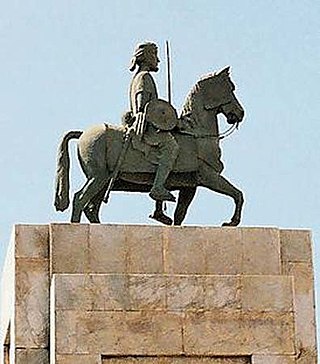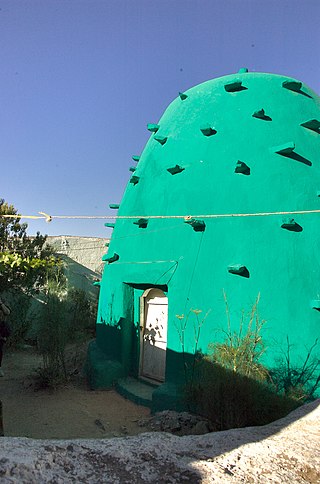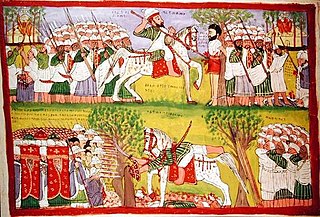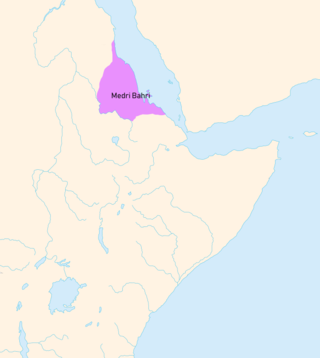
The Adal Sultanate, the Adal Empire, the ʿAdal, or the Bar Saʿad dīn, was a medieval Sunni Muslim Empire which was located in the Horn of Africa. It was founded by Sabr ad-Din III on the Harar plateau in Adal after the fall of the Sultanate of Ifat. The kingdom flourished c. 1415 to 1577. At its height, the polity under Sultan Badlay controlled the territory stretching from Somaliland to the port city of Suakin in Sudan. The Adal Empire maintained a robust commercial and political relationship with the Ottoman Empire. Sultanate of Adal was alternatively known as the federation of Zeila.

Ahmad ibn Ibrahim al-Ghazi was a military leader of the Adal Sultanate. Imam Ahmad, led the conquest of the Ethiopian Empire under the Sultanate of Adal during the Ethiopian-Adal War. He is often referred to as the "King of Zeila" in medieval texts.

Galawdewos also known as Mar Gelawdewos, was Emperor of Ethiopia from 3 September 1540 until his death in 1559, and a member of the Solomonic dynasty. His throne name was Asnaph Sagad I. A male line descendant of medieval Amhara kings, he was a younger son of Dawit II and Seble Wongel.

Sarsa Dengel, also known as Sarsa the Great, was Emperor of Ethiopia, and a member of the Solomonic dynasty. His throne name was throne name Malak Sagad I.

The Sultanate of Ifat, known as Wafāt or Awfāt in Arabic texts, was a medieval Sunni Muslim state in the eastern regions of the Horn of Africa between the late 13th century and early 15th century. It was formed in present-day Ethiopia around eastern Shewa in Ifat. Led by the Walashma dynasty, the polity stretched from Zequalla to the port city of Zeila. The kingdom ruled over parts of what are now Ethiopia, Djibouti and Somaliland.
The Hadiya Sultanate also known as Adea or Hadia was a medieval kingdom located in southwestern Ethiopia, south of the Abbay River and west of Shewa. By 1850, Hadiya is placed north-west of lakes Zway and Langano but still between these areas. Hadiya was historically like the state of the Adal federation and a opponent of Abyssinia.
Yeshaq was the Bahr Negus, or ruler of the Medri Bahri, during the mid to late 16th century A subordinate of Ethiopian Emperor Dawit II, he was noted for supporting Gelawdewos during the Ethiopian-Adal war, and rebelling against his successors.
Hadiya, also spelled as Hadiyya, is an ethnic group native to Ethiopia in Southern Nations, Nationalities and Peoples' Region who speak the Hadiyya language. According to a popular etymology, the name 'Hadiya," sometimes written in the versions Hadya, Hadea, Hadija, Hadiyo, Hadiyeh, Adea, Adia, means "gift of god" A historical definition of the Hadiya people based on the old Hadiya Sultanate included a number of Ethiopian ethnic groups currently known by other names. Currently, this historic entity is subdivided into a number of ethnonyms, partly with different languages and cultural affiliations. In his book "A History of the Hadiya in Southern Ethiopia," Ulrich Braukämper reported that Leemo, Weexo-giira, Sooro, Shaashoogo, Baadawwaachcho, and Libido (Maraqo) Hadiya subgroups remain a language entity and preserved identity of oneness, the Hadiya proper. In contrast, Qabeena, Halaaba, Welene and Gedebano, and Silt'e people developed separate ethnic identities. Clans of Hadiya origin in Oromia, Sidama, Wolayta, Gurage, Tigray, and Afar were completely absorbed by these nations. They were initially all inhabitants of a single political entity, a sultanate, which in the four centuries following its break-up in the mid-16th century fragmented into separate ethnic groups.

Nur ibn Mujahid ibn ‘Ali ibn ‘Abdullah al Dhuhi Suha was a Somali Emir of Harar who ruled the Adal Sultanate. He was known for marrying his uncle's widow, Bati del Wambara, and he also succeeded Imam Ahmad as leader of the Muslim forces fighting Christian Ethiopia.

The Ethiopian–Adal War or Abyssinian-Adal War, also known in Arabic as the "Futuḥ al-Ḥabash", was a military conflict between the Christian Ethiopian Empire and the Muslim Adal Sultanate from 1529 to 1543. Christian Ethiopian troops consisted of the Amhara then afterwards their allies, the Tigrayans, and Agaw people, and at the closing of the war, supported by a few hundred Portuguese musketmen. While Adal forces were mainly Harla and Somali, as well as Afar, Argobba, Hadiya, as well as Turkish and Arab gunmen. Both sides at times would see the Maya mercenaries join their ranks.

Medri Bahri, also known as Medre Bahr, was a semi-autonomous kingdom within the Ethiopian Empire, located in present day Eritrea and some surrounding areas. The kingdom was founded in 1448 when Emperor Zara Yaqob reorganized the northern highlands into one administration under a Bahr Negus.
The Oromo Invasions were a series of expansions in the 16th and 17th centuries by the Boorana starting from 48-64 kilometers east of Lake Abaya and around the Bale Mountains. Over the centuries due to many factors, mostly the wars against foreign forces and internal conflicts which preoccupied Ethiopia, would further encourage the numerous Oromo tribes to expand towards central Ethiopia.
Dawaro or Doaro was a Muslim principality which laid alongside the Ifat Sultanate. The state was originally independent until becoming a vassal and later a province due its subjugation by Emperor Amda Seyon I in the early 14th century.

Fatagar was a historical province that separated Muslim and Christian dominions in the medieval Horn of Africa. In the eleventh century it was part of the Muslim states, then was invaded by the Christian kingdom led by Emperor Amda Seyon I, after which it would serve as central district in, and home of multiple rulers of, the Ethiopian Empire in the 15th century.
A Malassay was a member of the elite infantry units that formed the Adal Sultanate's household troops. According to Manfred Kropp, Malassay were the Harari armed forces.
The Battle of Fatagar was a reprisal war between the participants of the previous Adal Sultanate and Ethiopian Empire in the Ethiopian-Adal war. It was fought between the forces of the Sultanate of Harar led by Nur ibn Mujahid, and the Ethiopian Empire under Emperor Gelawdewos. The Ethiopian Emperor was killed by Adal forces in this battle.
Damot was a historical region located in western Ethiopia. The region was situated south of Gojjam and covered most of Ethiopia's Welega Province. Until the fourteenth century it was ruled by its own independent kingdom, before its conquest by the Ethiopian Emperor Amda Seyon I, after which it would serve as an important province within the Ethiopian Empire during the medieval period.

Garad Matan bin Uthman Bin Khalid born c. early 1490 – 28 October 1531, also known as Garad Matan Bin Uthman bin Khalid Al Somali, was a Somali military commander and Adalite general that served the Adal Sultanate. He led in key and decisive battles, famously leading the Somali divisions. He was also the brother-in-law of Imam Ahmed and his right-hand man. Garad Matan played a very prominent role in the campaigns against the Abyssinians. Garad Matan hailed from the Geri Koombe clan and was also the chieftain. He was regarded as the most bravest, courageous military generals in Adal Sultanate well documented in the Futuh Al Habash.
Muhammad ibn Nasir, reigned 1573–1576, was a sultan of the Sultanate of Adal in the Horn of Africa.









